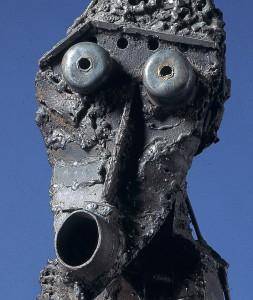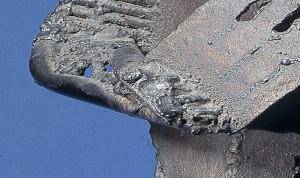Students will trace the biogeographical journey of the artist who created the sculpture Spiritual Messenger and examine how people and their work reflect the cultural experiences they have had. The students will share personal examples of activities and possessions that reflect a blending of different cultures, and then create an illustration with accompanying caption that shows an example of cultural fusion in their own lives.
Students will be able to:
- examine the artistic characteristics of the sculpture Spiritual Messenger;
- locate Uganda, Germany, France, and the United States of America on a world map;
- explain how cultures can blend as people, ideas, and goods move around the world; and
- create an illustration and accompanying caption that shows an example from their own lives that demonstrates cultural blending or fusion.
Lesson
1. Warm-up: Display or pass out copies of Spiritual Messenger and invite students to look carefully and share what they observe. What do they notice? What kinds of materials were used to make the sculpture? Where do they think these materials might have come from? What does the sculpture remind them of? How would they describe the expression on the sculpture’s face? What other adjectives might they use to describe the sculpture?
2. Share with students that the sculpture was created by Francis Nnaggenda in the 1970s. Nnaggenda was born and raised in central Uganda. After being exiled from Uganda under the dictator Idi Amin, Nnaggenda received his formal artistic education in Germany and France. Nnaggenda studied, taught, and worked in the United States, Europe, and other parts of Africa before returning to Uganda in 1978 at the end of Amin’s dictatorship.
3. Have the students locate Uganda, Germany, France, and the United States of America on a world map. Share some quick facts about Uganda, Germany, France, and the United States of America (e.g., geography, climate, languages, natural resources, government, history) by distributing or displaying information from appropriate websites such as:
4. Share with students that Nnaggenda’s work represents a fusion of his background and different experiences. Invite the students to reflect on the following: What are some aspects of Spiritual Messenger that might indicate that the artist has lived and worked in Africa, Europe, and the United States?
5. Ask the students to think of some other things that represent a fusion of two or more cultures. You may want to provide the students with examples like Korean BBQ tacos (blending of Hispanic and Korean influence) or flamenco music (emerging from a synthesis of at least four cultures including the Gypsies, Moors/Arabs, Jews, and indigenous Andalusians from Spain). Can the students think of any other kinds of food or music that represent a blending of cultures? Can they think of examples of cultural blending in architecture, clothing styles, recreation/sports, celebrations/holidays, and other areas? Record the students’ ideas on a piece of chart paper or (interactive) whiteboard.
6. Ask the students to identify something in their lives that represents a blending of cultures (e.g., the way their family celebrates certain holidays, certain foods they eat at home, ways they decorate their home, and so on). What different cultures are mixed together? How did these particular cultures come to influence the students’ families? Did some of the family’s ancestors move here from another country, or did the student’s family live in another geographical region at some point?
7. Invite students to draw an illustration that shows an example from their own lives that represents cultural blending. Ask them to include a written caption explaining how this illustration demonstrates cultural fusion. Tell the students to provide an appropriate title for their work, such as Cultural Blending (or Fusion) in My Life.
8. Ask for volunteers to share their illustrations and accompanying captions. If you have a large world map that can be displayed in the classroom, you may want to place a small red pin or small sticky note on each country or region of the world the students mention. Lead a class discussion on how people, ideas, and goods can move around the world, leading to a synthesis or blending of cultures.
Materials
- A piece of chart paper and colored markers or (interactive) whiteboard to record students’ thoughts contributed during class discussion
- Drawing paper and colored markers, pencils, and artistic supplies for each student
- Map of the world, visible to all students in the classroom
- Internet access to webpages of the World Factbook:
- About the Art section on Spiritual Messenger
- One color copy of the sculpture for every four students, or the ability to project the image onto a wall or screen
Standards
- Social Studies
- Geography
- Understand chronological order of events
- Analyze historical sources using tools of a historian
- Become familiar with United States historical eras, groups, individuals and themes
- Become familiar with United States family and cultural traditions in the past and present
- Become familiar with United States geography
- Become familiar with World geography
- Recognize similarities and differences about regions and people using geographic tools
- Understand people and their relationship with geography and their environment
- Use geographic tools and sources to answer spatial questions
- Visual Arts
- Observe and Learn to Comprehend
- Relate and Connect to Transfer
- Envision and Critique to Reflect
- Language Arts
- Oral Expression and Listening
- Research and Reasoning
- Writing and Composition
- Reading for All Purposes
- Collaboration
- Critical Thinking & Reasoning
- Information Literacy
- Invention
- Self-Direction

Spiritual Messenger
Denver Art Museum Collection
Gift of Robert and Mary Udall, 2001.644
Photograph © Denver Art Museum 2009. All Rights Reserved.
Francis Nnaggenda was born in 1936 and raised in central Uganda. Exiled from Uganda under the dictator Idi Amin, Nnaggenda received his formal artistic education in Germany and France beginning in the 1960s. He studied, taught, and worked in the US, Europe, and other parts of Africa before returning to Uganda in 1978 at the end of Amin's dictatorship. Nnaggenda has a variety of artistic talents-he is a sculptor, painter, and poet. He combines techniques he's learned around the world with traditions from Africa. "People tell me my work looks like Picasso, but they have it wrong. It is Picasso who looks like me, like Africa," he says. When asked in an interview when he knew he wanted to become an artist, Nnaggenda spoke of his childhood and his family. His mother and grandmother would tell him stories and sing to him, and he would create images after hearing those stories. "All children play with anything available," said Nnaggenda. "From the soft clay pushed up and out of the tops of anthills, I modeled. Flowers when smeared on certain surfaces left colours, but it was in primary school that I first came across pen, pencil, and paper. Drawing was taught and I took to decorating the pages I worked on."
Nnaggenda often uses recycled materials to create artworks; for this sculpture he used recycled car parts. He looks for materials in the world around him, taking objects he finds and transforming them into something new. His passion for found objects may reflect his interest in exploring “the inner life of things.” In reference to the human form he says, “I find myself closer to the human beings because they influence me more than anything else. I am a human being expressing human experiences. But again my interpretation of human beings is inseparable from their surroundings. My figures and forms are not mere imitations of nature. I am more interested in the inner life of things.” Nnaggenda illustrates this idea in one of his poems:
The dead are not under the earth
They are in the tree that rustles
They are in the woods that groan
They are in the water that runs…
Those who are dead are not gone
They are in the child wailing and in the fire that flames…
When my ancestors talk about the Creator, they say:
He is with us…We sleep with him.
We hunt with him…We dance with him.
Details

Human Figure
Nnaggenda’s sculpture is of an abstract standing human figure with bulging eyes and mouth open in the shape of an “O.” Its right arm folds in front, and its hand stretches towards its face.

Metal
Nnaggenda welded recycled chunks of metal and old car parts to create a new form. In his artwork, he incorporates found objects, hints of paint, and jagged textures. Nnaggenda does not always build his sculptures out of metal. He also uses wood, stone, bronze, and other media.
Funding for object education resources provided by a grant from the Morgridge Family Foundation. Additional funding provided by the William Randolph Hearst Endowment for Education Programs, and Xcel Energy Foundation. We thank our colleagues at the University of Denver Morgridge College of Education.
The images on this page are intended for classroom use only and may not be reproduced for other reasons without the permission of the Denver Art Museum. This object may not currently be on display at the museum.







